5 - Understanding Phrasal Rhythm: A Beginning
With the complexities you have just encountered in Donne, Sidney, Shakespeare, Milton and Shelley fully in your ears, I'd like to ask you to aurally recall as well as think back to the first examples you read for this tutorial, "Humpty Dumpty" and "A man whose name was Johnny Sands." The differences between these two groups of poems can, at one level, be ascribed to the differences between high culture and popular culture. That true but easy explanation would not, however, explain why poets in English since the Renaissance have tended predominantly to choose the iambic pentameter rather than the four stress meter or, for that matter, any of a number of other metrical forms. Historically, the reasons for this choice have not received very adequate explanation. Attempts to explain this preference have been hindered by the prevailing assumption that rhythm and meter are equivalent and that verse form is defined by the choice of meter. As you have seen from both the Attridge and generative approaches, rhythm is generally regarded as a deviation from a normative metrical pattern with complexity determined by the number and type of variations. In this conception of verse form, meter is what defines rhythm; rhythm is seen "as either a reinforcing or loosening of meter / beating" (DM 7). But if you think back to the last several exercises and examples, you will see that what we primarily focused on, indeed, what drives this poetry and makes it compelling, is the sense of the speaking voice. That voice is not produced by a rigid adherence to metrical beating but by the creation, though phrasal rhythm, of a distinctively shaped speech that rises out of, above and often in stark contrast to metrical beating.
One way to account for the rise of a personal voice in Renaissance poetry, a development simultaneously of voice, the pentameter and the sonnet form itself, is as the emergence and "establishment of a dominant phrasal order" (DM 7). In this understanding, rhythm is not regarded as a loosening of metrical constraint but an independent, even oppositional force, that has its own distinctive modes of organization. Richard Cureton argues that this emphasis on phrasing rather than meter helps to explain not only local, small-scale questions of rhythm but also large-scale issues of form and argumentation. In the discussion of RHYTHM in section 2, I quoted Cureton's distinction between meter and rhythm: meter is "physical, continuous, repetitive, rigid, local, and retrospective;" phrasing is "emotive, divisive, shaped, flexible, and centering / climactic" (DM 6). This distinction will, I hope, make better experiential sense to you now than it could then.
In other words, meter projects inflexible beating patterns, usually signaled at the outset of a poem or line by a strong beat that is then continued throughout. By contrast, phrases move in proportioned units whose shapeliness is perceived as they come to completion or climax, i.e., to cadence, usually at a line end. In contrast to meter which, like wallpaper, can go on and on in its pattern forever, phrasal rhythms are defined by their patterned contours, centered around peaks of tension and release, climax and relaxation. A four stress meter allows rhythm patterns that deviate wildly from the beat, e.g., nursery rhymes often have variable numbers of syllables between beats; or think of the relation in rap between the beat and the rhythm. Nonetheless the four stress or ballad meter are such strong meters that phrasing is repeatedly constrained by the quick return to initial beating. The pentameter, while lengthening the line by only two syllables, i. e., one beat, is a much weaker meter. The returning initial downbeat occurs less often and the strength of the meter tends to wane as a line progresses. Thus it became a natural choice for Renaissance poets who wanted to foreground the phrasal contours of the speaking voice.
But even among English Renaissance poets, there is a dramatic development of the phrasal possibilities of iambic pentameter. When Shakespeare began to write his sonnets around 1590 (they were published in 1609), the tradition of iambic pentameter developed by such poets as Wyatt, Surrey, Sidney and Spenser had relatively set features: 1) a ten-syllable iambic line; 2) a conventional mid-line break, usually dividing the line into a group of four syllables and a group of six syllables; 3) a predominance of end-stopped lines; and 4) a fairly regular congruence between the metrical pattern and the verse instance , i.e., a minimal number of labeling and bracketing mismatches or degrees of complexity (Wright 43; see his Chapter 3 for a detailed discussion of these developments). Consider the opening quatrain of Sonnet 37 in Spenser's sonnet sequence, Amoretti (I have given both Attridge and the generative analysis for illustrative purposes; you need not do both).
(29)
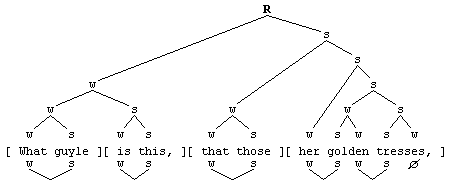
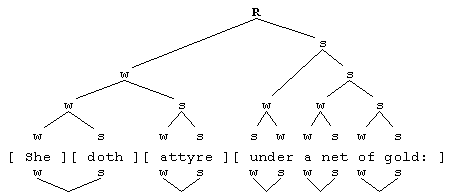
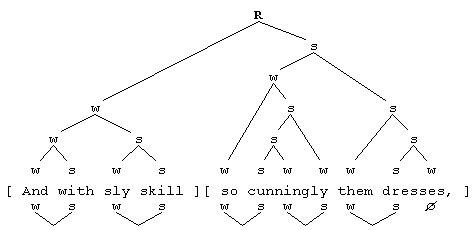
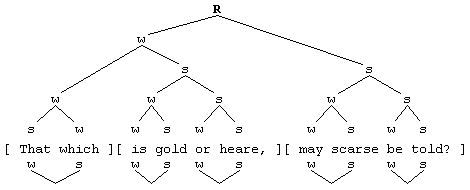
Each of these lines works fundamentally with a ten-syllable iambic line. The first and fourth lines are explicitly divided into groupings of four and six (or seven) syllables through the off-setting commas, while the middle lines are similarly divided through syntactic definition (And doth attire [verb phrase] /under a net of gold [prepositional phrase]://And with sly skill [prepositional phrase] so cunningly them dresses [verb phrase]). Each of the lines is end-stopped, both rhythmically and orthographically. Finally, the rhythmic phrases follow the metrical pattern quite closely; there is little of the expressive variation we saw, for instance, in Donne.
While Shakespeare wrote some sonnets that conform to the expected form as closely as Spenser does in Sonnet 37, he is generally credited with expanding the potential of the phrasal order, making his language more speech-like in the process. Wright articulates four sources of increased flexibility in the iambic pentameter: 1) trochaic phrasal rhythm; 2) increasing freedom in the treatment of the mid-line break; 3) a greater and more radical use of enjambment; and 4) the use of so-called feminine endings (an extra, i.e., eleventh unstressed syllable at the line end) (Wright 55-56). The third line of the Spenser sonnet provides an example of a feminine ending but it is, as the example shows, not very disruptive of metrical order and perhaps the weakest contributor to the development of an independent phrasal order. The beginning of Shakespeare's Sonnet 129 provides a good example of the other three of these features.
(30)
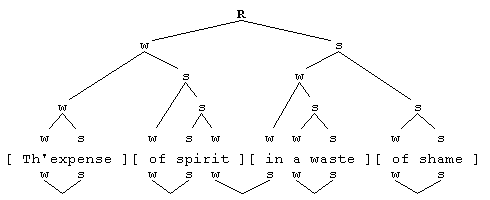
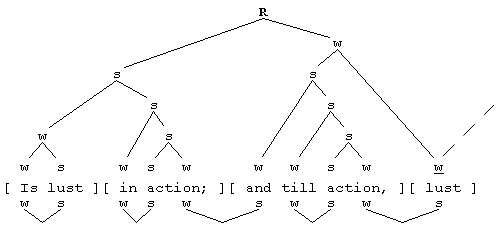
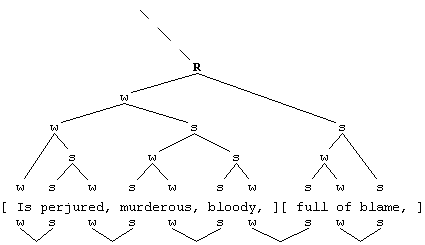
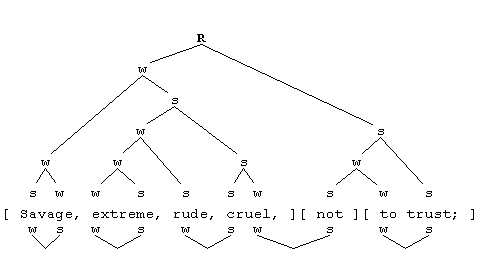
Trochaic rhythms dominate line three and part of line four, as reflected by the bracketing mismatches and, in the case of "Savage," by a labeling mismatch. While these mismatches are an acceptable deviation from the iambic norm, they also signal a motion fully contrary to what the meter leads one to expect, lending the lines a sense of being simultaneously rooted in but independent from the meter. As one speaks them aloud, one's ear is definitely tuned to the almost relentless falling rhythms of the adjectives, including cruel, which is here pronounced as a di-syllable (Booth 443-444). In addition, the last line, at least in the generative system, would be considered unmetrical because of the simultaneous bracketing and labeling mismatch on "rude." The rude internal divisions of the speaker are enacted at another level in the theatricalized contest between meter and rhythm.
Changes in the treatment of the mid-line break and the increased use of enjambment are inter-related phenomena. As we saw in examples 22 and 28, the later in the line that a pause occurs, especially one marked by punctuation, the more likely that enjambment will occur. In addition, by eschewing the four syllables plus six syllables configuration, poets increase the variety and shape of their phrases. In line two, for example, Shakespeare begins with a five-syllable phrase, "Is lust in action," followed by a strong stop on the semi-colon. He continues with a four-syllable phrase, "and till action," ending with at least a minimal pause at the comma following "action." "Lust," the thematic heart of the poem, is thus stranded alone on the line end, precipitating the enjambment completed in the long verb phrase strung out over lines three and four.
The effects of Shakespeare's phrasal shaping of these lines are several and they have significant interpretive consequences. The strong medial break in line two divides the line into two uneven phrases, making the phrase rather than the evenly measured iambic metrical unit, the unit of perception. The isolation of "lust" at the line end highlights its rhythmic as well as thematic ambiguity and complexity. On the one hand, "lust" is the climax of the line since it occupies a metrically strong position and it completes syntactically the chiastic structure of the line. "A CHIASMUS is a sequence of two phrases or clauses which are parallel in syntax, but with a reversal in the order of the corresponding words" (Abrams 162). On the other hand, the pause before "lust" and the carry over of the syntax into the next two lines weakens the closure on "lust," making the line temporally forward looking. The chiasmus works both a syntactic and a temporal reversal, suggesting a contrary motion within the language itself.
The quatrain as a whole can be broken into two larger phrasal groups, divided by the semi-colon in line two. The coherence of lines three and four as a distinct sub-grouping is underscored by their syntactic parallelism, the largely parallel falling rhythms in the string of adjectives, and the syntactic and rhythmic equivalence of the final and judgmental three-syllable groupings, "full of blame" and "not to trust." Finally, the first quatrain is not as self-enclosed as our usual descriptions of the sonnet form would make us think. The fourth line ends not with a period but a semi-colon, signaling both a continuing syntactic structure and a continuing readjustment on the reader's part of relations of prominence and hierarchy on the temporal and moral planes. While meter leads us to expect closure at each line end, Shakespeare's phrasal rhythms continually delay our sense of completion and climax, requiring a constant re-assessment of the dimensions of the speaking voice that is temporally unfolded in the poem.
The sense conveyed by the phrasal structures of the opening quatrain is one of the speaker turning back upon himself in conflict and uncertainty, pulled first one direction and then another, desiring and then ruing the desire that brings him so low, despising even the shame that is wasted in contemplation of his dissolute state. The regularities of a rhythm completely fitted to meter could not begin to structure the drama of such feeling, thought and expression. The phrasal patterns that Shakespeare uses trace the rise and fall of a mind seeking both to express and understand itself in a context where the affections may be wed to conflicting ends and where speech itself becomes the locus for hearing and sorting out the cadences of contemplation in action.
As you leave this tutorial for reading and enjoying more poems, you may want to think about the broader implications of what you have learned about rhythm, considering such issues as how rhythm organizes our perception of time, both local and global, how forms give shape to time, including our senses of expectation, duration and completion, how forms of argument and figurative language work sometimes in concert and sometimes at odds with other temporal structures such as line, stanza, verse paragraph or rhyme schemes, and finally, how the awareness of multiple temporal structures within a poem creates new and rich expectations of you as a reader.
To help you test out your understanding of the analytical tools you have learned and to think further about phrasal rhythm, I leave you with one last exercise, this time an entire poem.
Using either the Attridge or generative methods, scan all of Shakespeare's Sonnet 64 (#12a will give the Attridge scansion; #12b will give the generative scansion). When you have completed your scansion, consider these questions: 1) What kinds of rhythmic complexity does Shakespeare use, where does it occur and what are the local effects of these complexities? 2) What's the connection between rhythmic complexity and meaning? 2) Where does he use enjambment and what are its effects? 3) At what points in the poem do you become aware of the phrasal rhythms working at odds with or almost independently of the meter? 4) How do the rhetorical or syntactical structures of the poem work in relation to these phrasal rhythms? Think about parallelism and chiasmus as a start to this process.
12a
12b